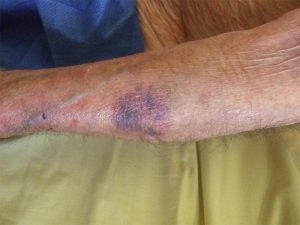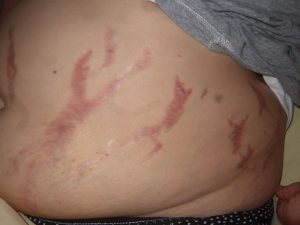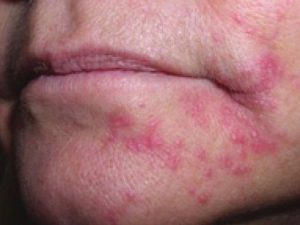Skin disorders
Description: corticosteroids may trigger adverse skin reactions that usually correspond to one of three types:
- trophic (skin fragility) -this includes stretch marks, bruises, dry skin, difficulties for healing. (Figure 1-2)
- infections
- others : e.g., acne (Figure 3), perioral dermatitis (Figure 4), increased hair growth, depigmentation
Frequency: it is hard to estimate the frequency of skin disorders. Different studies that have been conducted found that anywhere from 5 to 70% of patients experienced them. This is likely highly dependent on the study populations and the dose of corticosteroids.
Subjects at risk: we know very little at this time. However, it has been observed that women are more likely to develop trophic disorders than men.
Treatment versus short-term treatment: there seems to be an increased risk of skin disorders from small doses of corticosteroids (from 5 mg/per day of prednisone or prednisolone for example)
Prevention/treatment: there is no known prevention or cure to these effects of cortisone on the skin. It is advisable to use an effective skin moisturizer during treatment. Please avoid applying creams containing cortisone to the face as it can cause acne or perioral dermatitis.
Reversiblity: there are some skin conditions (e.g. increased body hair, acne, infections) that are reversible after discontinuation of treatment. However, trophic disorders can persist long after the corticosteroids have been ended.

Skin fragility (Bateman’s purpura)

Figure 2: stretch marks

Figure 3

Figure 4: peri-oral dermitis
- Katz HI et al. Preatrophy: covert sign of thinned skin. J Am Acad Dermatol. 1989
- Fardet L et al. Corticosteroid-induced clinical adverse events: frequency, risk factors and patient’s opinion. Br J Dermatol. 2007
- Huscher D et al. Dose-related patterns of glucocorticoid-induced side effects. Ann Rheum Dis. 2009
- Curtis JR et al. Population-based assessment of adverse events associated with long-term glucocorticoid use. Arthritis Rheum. 2006